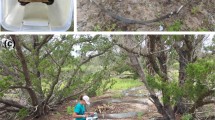Summary
Eastern screech owls bring live blind snakes to their nestlings, whereas all other prey are delivered dead. Some of the snakes are eaten but most live in nest debris, where they eat soft-bodied insect larvae from the decomposer community in fecal matter, pellets, and uneaten prey. Consumption of larvae may reduce larval parasitism on owl nestlings or larval competition with nestlings for food stored in the nest, because nestlings with live-in blind snakes grow faster and experience lower mortality than same-season broods lacking snakes. We propose a commensalistic association in which the screech owl benefits reproductively and the live-in blind snake is not affected.
Similar content being viewed by others
References
Balgooyen TG (1976) Behavior and ecology of the American Kestrel (Falco sparverius L.) in the Sierra Nevada of California. Univ Calif Publ Zool 103:1–83
Gehlbach FR (1987) Environmental and population features that permit adaptation to urban ecosystems: the case of eastern screech owls (Otus asio) in Texas. Proc. 19th Internatl Ornithol Congress, Ottawa (in press)
Gehlbach FR, Watkins II JF, Reno H (1968) Blind snake defensive behavior elicited by ant attacks. BioScience 18:784–785
Ligon JD (1968) The Biology of the Elf Owl, Micrathene whitneyi. Mus Zool Univ Michigan Misc Publ 136:5–70
McComb WC, Noble RE (1981) Microclimates of nest boxes and natural cavities in bottomland hardwoods. J Wildl Manage 45:284–289
McComb WC, Noble RE (1982) Invertebrate use of natural tree cavities and vertebrate nest boxes. Amer Midl Natur 107:163–172
Philips JR, Dindal DL (1977) Raptor nests as habitat for invertebrates: a review. Raptor Res 11:87–96
Philips JR, Root M, Desimone P (1983) Arthropods from a sawwhet owl nest in Connecticut. Entomol News 94:60–64
Punzo F (1974) Comparative analysis of the feeding habits of two species of Arizona blind snakes, Leptotyphlops h. humilis and Leptotyphlops d. dulcis. J Herpetol 8:153–156
Vanzolini PE (1970) Climbing habits of Leptotyphlopidae (Serpentes) and Walls' theory of the evolution of the ophidian eye. Papeis Avulsos Zool 23:13–16
Watkins JF II, Gehlbach FR, Kroll JC (1969) Attractant-repellent secretions in blind snakes (Leptotyphlops dulcis) and army ants (Neivamyrmex nigrescens). Ecology 50:1098–1102
Author information
Authors and Affiliations
Rights and permissions
About this article
Cite this article
Gehlbach, F.R., Baldridge, R.S. Live blind snakes (Leptotyphlops dulcis) in eastern screech owl (Otus asio) nests: a novel commensalism. Oecologia 71, 560–563 (1987). https://doi.org/10.1007/BF00379297
Received:
Issue Date:
DOI: https://doi.org/10.1007/BF00379297




